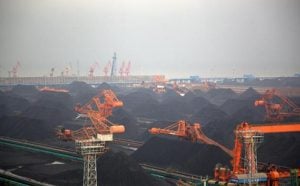Some of the world’s major economies are moving towards reducing their dependence on coal. In June this year, US President Obama unveiled a Presidential Climate Action Plan, including a call for a halt to government support for public financing of new coal power plants overseas; in July both the World Bank and the European Investment Bank announced they would no longer finance coal power. China has recently announced its intention to change its pattern of coal consumption in an effort to fight air pollution.
But the shift away from coal is driven by different factors in each country. In the US the reduction in coal has been made possible by its huge supplies of shale gas, while China’s moves to reduce coal use are the outcome of industrial development and restructuring, with the aim of achieving an early peak in total coal consumption.
China’s coal sector has enjoyed a golden decade but is now going through a period of overcapacity and restructuring. China’s economic growth has slowed, with the growth in coal demand slowing even further due to state restructuring of energy-hungry and high-emissions sectors, and the on-going shift to more efficient, cleaner sources of energy.
Two other important factors are the global economic slump and the changes in commodity prices brought about by America’s “shale gas revolution.” As part of a national plan to combat air pollution the Beijing-Tianjin-Hebei region and the Yangtze and Pearl deltas are working to stop coal consumption increasing. Some of the more optimistic think tanks are calling for the government to bring about a coal consumption peak as early as 2015.
China hopes that increasing the use of gas will allow it to meet these goals. In the action plan on air pollution published in September particular emphasis was given to the production of gas produced from coal.
But we should remain cautious about the role gas can play in reducing coal use. In particular we should consider the long term political and economic implications.
The risks of replacing coal
Moving sources of pollution, such as power plants, out of the most heavily-polluted regions and into under-developed regions with greater environmental capacity may bring hazards in the longer-term. The construction of new plants would allow for the use of cleaner and more efficient technology, but would still bring more pollution to the north-west. This would worsen already grave water shortages and environmental problems, potentially ruining the north-west’s role as an environmental buffer.
In the long-term relocating the pollution may not be worthwhile – for example the clean air measures taking in the run-up to the Olympics have proved inadequate to prevent the heavy smog that Beijing frequently suffers. The relocation of energy-hungry and polluting companies such as Capital Steel did nothing to reduce regional pollution and the temporary relief for the environment was quickly cancelled out by the increase in other sources of pollution.
Replacing coal with gas may in the short term provide cleaner energy for key regions. But we must accept that China is not a major producer of either gas or oil, the so-called cleaner fossil fuels. Converting coal-fired power stations in northern China to run on gas would make ensuring security of supply a significant handicap. Though China has signed a major gas deal with Russia, supply has been disrupted to some of its other energy clients in the past.
A reliance on natural gas may have unexpected consequences for China. At the very least we should plan for such emergencies. Currently China is working on a deeper strategic partnership with Russia, and also hopes to improve relations with the Central Asian nations as part of a “Silk Road” regional economic strategy (such as the recent deal with Turkmenistan). Creating energy routes to both China’s north and west will inevitably require it to balance regional geopolitics with China’s further penetration into Central Asia.
Switching to gas or bringing electricity in from outside will only reduce the region’s carbon intensity to a limited extent. China’s first tier cities – Beijing, Shanghai, Guangzhou, Shenzhen – and the more developed coastal provinces must lead China to an early carbon peak and a low-carbon transformation – or the systemic risks of climate change will still exist for these coastline economies, as the IPCC report implies.
The key to the current environmental problems is the make-up of China’s energy. Reducing coal use in a country that has plenty of coal, but little else is a huge challenge, but also an opportunity for renewable energy to make further technological and economic advances. The expansion of cleaner fossil fuels should only be used on a temporary and localised basis in the short and medium-term to provide space for the longer-term switch to renewables. These measures based on fossil fuels still need to be developed in consistent with China’s master plan on renewable energy development. As well as promoting the generation and supply of renewable energy, the government should further boost the strategic role of renewables in the energy and electricity system, and ensure these sources of energy become dominant.







